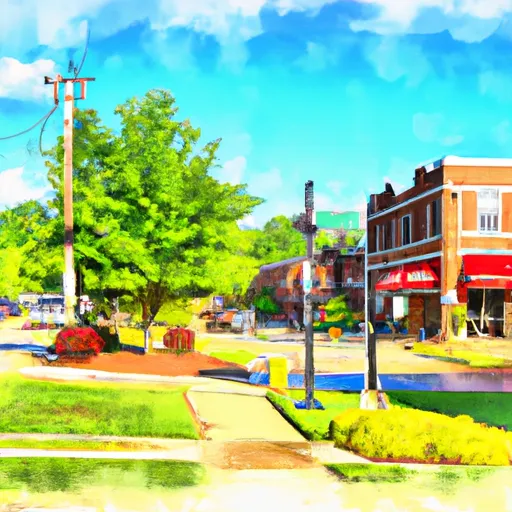-
 Snoflo Premium
Snoflo Premium
Get unlimited access to all our content
With no Ad interruptions! - Start Your Free Trial Login with existing account
Millcreek
Eden Index
Climate
8.3
•
Recreation
2.1
•
Community
2.1
•
Safeguard
4.5/10

Millcreek, Missouri is a picturesque town located in the heart of the Ozarks, known for its stunning natural beauty and abundant outdoor recreation opportunities. The town enjoys a moderate climate, characterized by four distinct seasons. Summers are warm and humid, with temperatures averaging around 85°F, while winters can be cold with temperatures dropping to an average of 30°F. Spring and fall offer pleasant temperatures, making them ideal for outdoor activities.
Millcreek is blessed with an extensive hydrology system, with numerous creeks, streams, and ponds running through the area. These water bodies support a diverse range of aquatic life, making it a haven for fishing enthusiasts. The town also boasts several picturesque hiking trails, where visitors can explore the beautiful surrounding forests and enjoy the tranquility of nature.
In addition, Millcreek offers various outdoor recreation opportunities, including camping, boating, and wildlife watching. The town is home to several well-maintained campgrounds and parks, providing a perfect setting for family outings or peaceful retreats. With its stunning landscapes, abundant water resources, and diverse outdoor activities, Millcreek is a destination that will captivate nature lovers and outdoor enthusiasts.
What is the Eden Index?
The Snoflo Eden Index serves as a comprehensive rating system for regions, evaluating their desirability through a holistic assessment of climate health, outdoor recreation opportunities, and natural disaster risk, acknowledging the profound impact of these factors on livability and well-being.
Climate Health Indicator (CHI): 8.3
Millcreek receives approximately
1148mm of rain per year,
with humidity levels near 85%
and air temperatures averaging around
13°C.
Millcreek has a plant hardyness factor of
6, meaning
plants and agriculture in this region thrive during a short period during spring and early summer. Most
plants will die off during the colder winter months.
By considering the ideal temperature range, reliable water supplies, clean air, and stable seasonal rain or snowpacks, the Climate Health Indicator (CHI) underscores the significance of a healthy climate as the foundation for quality living.
A healthy climate is paramount for ensuring a high quality of life and livability in a region, fostering both physical well-being and environmental harmony. This can be characterized by ideal temperatures, reliable access to water supplies, clean air, and consistent seasonal rain or snowpacks.
Weather Forecast
Streamflow Conditions
St. Francis
Area Rivers
St. Francis
Snowpack Depths
St. Francis
Reservoir Storage Capacity
St. Francis
Groundwater Levels
Recreational Opportunity Index (ROI): 2.1
The Recreational Opportunity Index (ROI) recognizes the value of outdoor recreational options, such as parks, hiking trails, camping sites, and fishing spots, while acknowledging that climate plays a pivotal role in ensuring the comfort and consistency of these experiences.
Access to outdoor recreational opportunities, encompassing activities such as parks, hiking, camping, and fishing, is crucial for overall well-being, and the climate plays a pivotal role in enabling and enhancing these experiences, ensuring that individuals can engage in nature-based activities comfortably and consistently.
Camping Areas
| Campground | Campsites | Reservations | Toilets | Showers | Elevation |
|---|---|---|---|---|---|
| Bayou Segnette State Park | None | 0 ft | |||
| Mississippi Petrified Forest | 15 | 294 ft | |||
| Lake Lincoln State Park | None | 426 ft | |||
| Fairview Riverside State Park | None | 4 ft | |||
| Greenville - Lake Wappapello | None | 382 ft | |||
| Atwood Water Park | None | 218 ft | |||
| Percy Quin State Park | None | 416 ft | |||
| Lefleurs Bluff State Park | None | 288 ft | |||
| Bogue Chitto Water Park | None | 276 ft | |||
| Lake Mary Crawford | 20 | 293 ft |
Nearby Fishing
Nearby Ski Areas
Catastrophe Safeguard Index (CSI):
The Catastrophe Safeguard Index (CSI) recognizes that natural disaster risk, encompassing floods, fires, hurricanes, and tornadoes, can drastically affect safety and the overall appeal of an area.
The level of natural disaster risk in a region significantly affects safety and the overall livability, with climate change amplifying these risks by potentially increasing the frequency and intensity of events like floods, fires, hurricanes, and tornadoes, thereby posing substantial challenges to community resilience and well-being.
Community Resilience Indicator (CRI): 2.1
The Community Resilience Indicator (CRI) recognizes that education, healthcare, and socioeconomics are crucial to the well-being of a region. The CRI acknowledges the profound impact of these elements on residents' overall quality of life. By evaluating educational resources, healthcare accessibility, and economic inclusivity, the index captures the essential aspects that contribute to a thriving community, fostering resident satisfaction, equity, and social cohesion.

